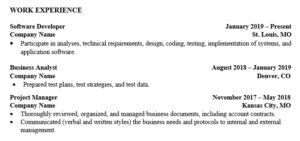As a staffing agency, we see a ton of resumes from different candidates. The resumes we see are all unique and vary in many ways. For example, some resumes are ten pages long while others are one page long. Resumes might be formatted based on personal preferences, how much experience the person has, or the job position they are applying for. One factor that doesn’t vary is that the information and formatting of a resume will have a great impact on landing a job. Considering that resume formatting is one of our many jobs here at ASG, we would like to share a few tips that anyone can use to keep their resume format professional, competitive, and to the point.
1. The introduction to the resume
Don’t know how to start your resume? First things first, your name should be the first thing a potential employer sees. It can be bolded or in a larger font and is always located at the top of the first page. Directly below your name is your contact information (address, phone #, email) in a smaller font.
Example of a header:

What’s next? Well, this can be a personal preference. Some people like to have an objective, however, that is not always necessary. An objective on a resume states what kind of career you are seeking and what skills and experiences you have that make you ideal for that career. Keep the objective one to two sentences if adding one. A professional summary is another great way to kick off a resume. A professional summary is a summary of your professional skills and experiences. The professional summary demonstrates your unique value through skills and accomplishments. Some people also put their education at the top, this is only necessary if you have just recently graduated; otherwise, education should be at the bottom.
Example of a professional summary:
2. Simplicity
Keep it simple. Know your audience. If you are applying to a more traditional company, a classic black-and-white resume will do the trick. If you are applying to a job where they want to see your creativity, using pops of color and design throughout your resume could be beneficial. Above all, remember that the most important part of your resume is the information; do not get stuck on color and fonts, focus on the information. Examples of appropriate fonts to use on a resume are Cambria, Calibri, Verdana, Courier New, and Times New Roman. The appropriate font size is between 10-12pt.
3. Organization of the resume
Keep it organized. Job experience and education should be listed in chronological order from most recent to oldest. When describing a past job make sure you use the past tense, if it is a current job make sure you use the present tense. Check for errors throughout the resume by using a site like Grammarly or having a peer review it. It is easy to miss mistakes when reviewing your work so double-check!
Examples of chronological order:
4. Keep it relevant
When listing past jobs, only list the jobs that are relevant to the current job you are applying for. For example, if you worked at a restaurant in 2006 and are now applying to a Software Developer role, that restaurant job is irrelevant to the employer and will take up space on the resume. When altering your resume to fit a certain job it’s a good idea to read through the job description, identify keywords throughout that description, and add them to your resume where appropriate. The length will vary based on your experience but remember NOT every job you have ever worked is necessary; keep it to the point. Also, when listing job responsibilities do not make them too brief. Take the next step and explain how that job responsibility helped you, your boss, the company, or team members. Think about why that job responsibility was so important and relay that in a bullet point.
Example of a well-written responsibility:
5. Market yourself.
Resumes are all about marketing yourself. You, as an applicant are trying to prove to the employer that you will be a great asset to the company and that you are equipped for the job. List technical skills, professional skills, personal skills, past job experience, education, and certifications; anything that will show that you are the best fit for the job!
Adaptive Solutions Group is an IT Recruiting & Staffing Company in St. Louis and Kansas City, MO.
If you are in the job market and would like help with your resume, let our recruiting pros assist.
For more information please contact us at info@adaptivesg.com



